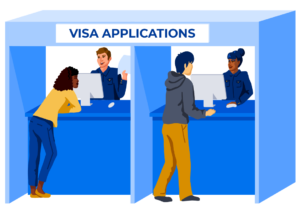To apply for a Canadian study permit, most international students will need to submit their biometric information. They may also need to pay a biometric fee. The student visa application process can be intimidating, so we’ve shared some information about the biometrics process from the Government of Canada below.
Planning to apply for a Canadian student visa? Read through our list of dos and don’ts first.

What Are Biometrics for Visa Applications?
Biometrics are body measurements and calculations that quantify human characteristics. To apply for a Canadian study permit, the biometrics you’ll be asked for include electronic fingerprints and a digital photo.
Canadian visa officers can use biometrics to confirm you are who you say you are. This makes it more difficult for someone to forge your identity and makes resolving errors easier. After you give your biometrics, they’ll be secured in a Government of Canada database.
The Royal Canadian Mounted Police (RCMP) will check your fingerprints against the fingerprint records of criminals, refugee claimants, deportees, and temporary resident applicants. Any matches to existing records will be analyzed by a visa officer to make a decision on your application.

Who Needs to Give Biometrics for Visas?
Wondering if you need to include biometrics with your student visa application? The Canadian government has a short questionnaire to tell you if you need to submit biometrics.
Generally, you must provide biometrics for visa applications if you’re applying for:
- A visitor visa
- A work or study permit
- Permanent residence
- Refugee or asylum status
- An extension of your stay in Canada, known as a visitor record
- A work or study permit extension
There are a few exemptions from these requirements. Citizenship applicants, existing permanent residents, children under the age of 14, and applicants over the age of 79 don’t need to give biometrics. United States citizens and green card holders (permanent residents) also don’t need to give their biometric information.
Under certain conditions, some individuals may not have to provide biometrics with their applications. You can find out if a temporary measure for biometrics applies to you on the Canadian government website.
Submitting a study plan with your Canadian student visa application? Here are some tips to make yours stand out.
How Long are Biometrics Good For?
Did you give biometrics in the last 10 years for a Canadian visitor visa, work permit, or study permit? If you did, you don’t have to give them again if you’re applying to visit, work, or study in Canada. Your biometrics are still valid for future applications within 10 years, even if your previous application was unsuccessful.
To see if your biometrics are still valid, use the Government of Canada’s Check Status tool.

How to Submit Your Biometrics for Visa Applications
First, pay the biometric fee for your Canadian student visa when you submit your visa application. It costs C$85 for an individual applicant, or a maximum total fee of C$170 for families applying together. Once you’ve paid the fee, you’ll get an instruction letter, which allows you to give your biometrics in person.
Once you receive your instruction letter, make an appointment to give your biometric requirements at a collection service point. While emergency walk-ins may be accommodated, it’s best to make an appointment in advance. It’s free to book a biometrics appointment, and booking can be done online. You must bring both your valid passport and your biometric instruction letter to your appointment. Your visa application won’t be processed until you submit your fingerprints and photo.
Photo Tips
Here are some steps to follow when having your photos taken:
- The photo must be taken in person by a commercial photographer or studio.
- Photos must be printed on plain, high-quality photo paper (not photos you print at home).
When you have your photograph taken, your whole face must be clearly visible. You can request to have your photo taken by a person of the same gender, and can also ask for a privacy curtain. - You may wear headgear or a hat that you regularly wear for religious or medical reasons as long as your whole face is visible.
- If you use a wheelchair, drape a white cloth over the back of the chair so it doesn’t appear in the photo.
- Don’t wear white or light clothing, including headgear. Bright colours are best.
Fingerprint Tips
Some things to keep in mind when giving your fingerprints:
- Don’t wear henna on your hands, as it can obscure your fingerprints.
- Make sure any injuries, cuts, or cracks on your fingertips have healed before giving your fingerprints. If your fingerprints don’t capture well, you may need to make a second appointment.
Processing Times
How fast you get your instruction letter depends on how you apply and when you pay your biometrics fee. Find more information on the Government of Canada’s biometrics page.
The time it takes you to give your biometrics isn’t included in the overall study permit application processing time. Visa officials won’t start processing your application until they receive your fingerprints and photo.

Strategies for Reducing Application Timelines
Here’s how to avoid study permit application delays:
- Apply online or in-person at a Visa Application Centre.
- Pay the application and biometrics fees when you submit your application.
- Give your biometrics at the same time you apply at a Visa Application Centre, or as soon as possible after getting your Biometric Instruction Letter.
- If you have a permanent injury or medical condition on your face or hands, bring any documentation you have about your condition to your Visa Application Centre appointment.
Ready to find a study program that matches your goals? Check out the ApplyBoard platform.







